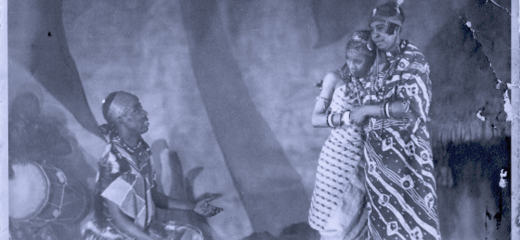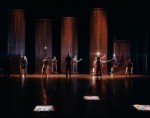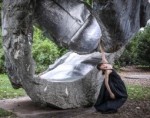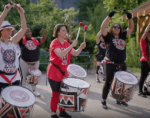
“Dancing the World Smaller” Tackles the Big Topic of Cultural Dance in America
by Darcy Grabenstein
If I had been looking for a little light reading to round out my summer, Dancing the World Smaller by Rebekah J. Kowal would not fit the bill. Kowal teaches dance history and theory at the University of Iowa, and her book reads like a thesis paper. It did, however, give me a new understanding of how far we’ve come (or haven’t) in terms of cultural dance in America.
The book’s title comes from a headline for a review of a 1943 African dance festival at Carnegie Hall, quoting Kingsley Ozumba Mbadiwe, director of the African Academy of Arts and Research (a pan-Africanist, anti-colonialist organization): “This is a small world. We must make it smaller.” This concept, in short, makes the case that dance can serve to unify diverse cultures. As someone who dabbles in international folk dancing, I would agree. Author Kowal puts this theory to the test against select dancers and events in New York City between 1940 and 1948, and finds it lacking in many respects. When the theory is narrowly viewed from the perspective of this mid-century slice of Americana, however, I would concur that cultural dance did not accomplish the goal of unifying peoples.
The first example cited by Kowal is the Around the World with Dance and Song series presented at the American Museum of Natural History. While the program succeeded in elevating ethnic self-definition, she contends, it also initially reinforced assumptions about Western cultural superiority. The first performances were held in the museum’s exhibition hall, where native peoples were depicted as exotic but subhuman natural resources. By today’s standards, an international song and dance program is not exactly a radical concept. At the time (1943-1952), however, it was a program that took a risk, in terms of content and context. The program did, over time, mark a shift in the museum’s treatment of ethnic dance from specimen to artistic practice.
Kowal tackles the issue of cultural appropriation by spotlighting La Meri, a white dancer who specialized in the dances of Asia, Spain, and Latin America and whose work was seen as more entertainment than education. Dance critic Walter Terry raised questions about the legitimacy of her work as art, calling her a “recreative” vs. “creative” artist (p. 74). The legitimacy of La Meri’s performances was questioned from a cultural perspective, too. Her African-American counterparts—including artists Zora Neale Hurston, Katherine Dunham, and Pearl Primus—routinely faced critical skepticism regarding the validity of the cultural material they adapted for the concert dance stage, even though they were presenting interpretations of their own cultural heritage.
The book sheds light on the cultural and political significance of a series of African dance festivals at Carnegie Hall. They were produced by the African Academy of Arts and Research. Choreographer Asadata Dafora, a classically trained opera singer from Sierra Leone, produced the series. This series, Kowal writes, “illuminates roles for the black dancing body in making and keeping history, and in furthering the political mobilization of black peoples in mid-century America” (p. 121).
Kowal also references a tour Dafora and his company, the Shogola Oloba African Dance Group, took in the 1940s to historically Black colleges in the American South and Midwest, which signaled support for Black civil rights. I found it interesting that Kowal, citing historian James H. Meriwether, notes that at mid-century, many African-Americans were ambivalent about their racial and cultural connections to Africa. Like their white contemporaries, he observed, they were swayed by negative African stereotypes depicted in education, the media, and society as a whole.
Dafora’s performances, Kowal notes, served to further the political mobilization of black peoples in mid-century America. This brings to my mind a recently published collaborative thINKingDANCE opinion piece in which I contend that the arts and politics are inevitably intertwined. I find both that the arts often provide commentary on sociopolitical issues and that our politics impact every aspect of our lives, including dance.
Lastly, Kowal focuses on the international dance festival at the 1948 Golden Jubilee Celebration in New York City. Of the fourteen countries invited by producer Sol Hurok, only three accepted the invitation: France, India, and the U.S. The festival revealed how dance as a medium of mid-century globalism both emphasized difference and promoted unification. Politics, the Cold War context, and homophobic anxiety also came into play when the Paris Opera Ballet, helmed by controversial artistic director Serge Lifar, performed at the festival. Some dancers picketed the performance because Lifar had been accused of collaborating with the Nazis during World War II. Columnist Walter Winchell slurred Lifar as a “queerographer.” I couldn’t help but wonder how many in the dance community would react today if faced with a similar situation, torn by competing internal loyalties of denouncing fascism and supporting LBGTQ artists.
In conclusion, Kowal writes that this era in America was marked by questions of “what it meant to live in a world that was at once interconnected, symbiotic, and international in scope at the same time it remained divided by myriad differences of culture, religion, race and ethnicity, economics, and politics” (p. 202).
Although it’s not what I consider an easy read, I recommend this book for anyone interested in exploring the evolution of cultural dance performance in America. Unfortunately, I see similar parallels (and divides) in today’s dance community: ballet vs. contemporary, traditional vs. urban, masculine vs. feminine, East vs. West. For me, the end of this book is only a beginning. I would be interested in seeing follow-up studies on cultural dance in America in the decades that follow, and what trends are revealed, leading up to today’s culturally diverse dance repertoire.
Above image caption: Asadata Dafora as the Bridegroom, with two women dancers, in a scene from Kykunkor, ca. 1934. Photograph: Maurice Goldberg. Courtesy of the Photographs and Prints Division, Schomburg Center for Research in Black Culture, New York Public Library.
Homepage image caption: Ram Gopal, Royal Opera House, 1948; Photographer: Roger Wood. Courtesy of ArenaPAL; www.arenapal.com and Jerome Robbins Dance Division, The New York Public Library for the Performing Arts.
Rebekah J. Kowal, Dancing the World Smaller: Staging Globalism in Mid-Century America. Oxford, UK: Oxford University Press, 2019. 296 pp.
By Darcy Grabenstein
September 22, 2020










